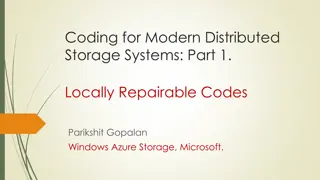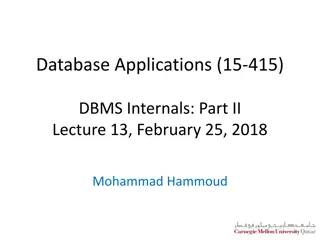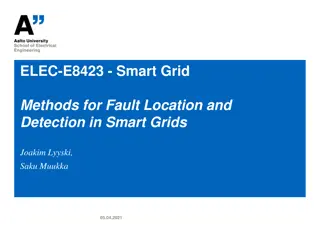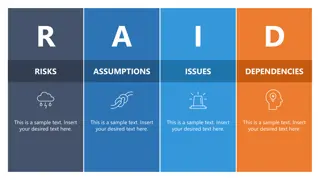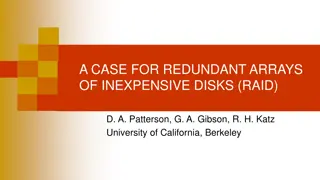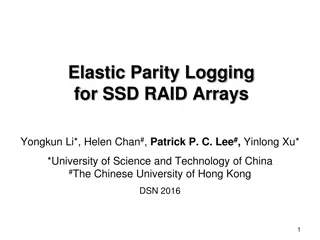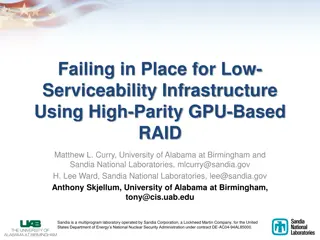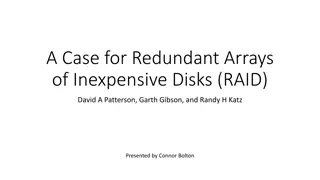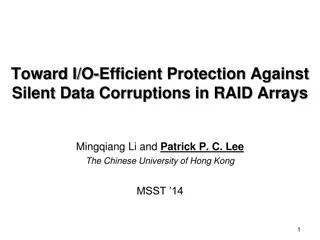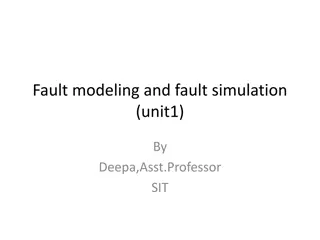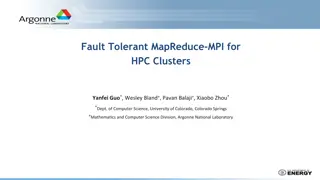Understanding RAID 5 Technology: Fault Tolerance and Degraded Mode
RAID 5 is a popular technology for managing multiple storage devices within a single array, providing fault tolerance through data striping and parity blocks. This article discusses the principles of fault tolerance in RAID 5, the calculation of parity blocks, handling degraded mode in case of disk failures, and strategies for data recovery. Learn how RAID 5 offers a balance between performance and redundancy in storage solutions.
Uploaded on Sep 16, 2024 | 0 Views
Download Presentation

Please find below an Image/Link to download the presentation.
The content on the website is provided AS IS for your information and personal use only. It may not be sold, licensed, or shared on other websites without obtaining consent from the author. Download presentation by click this link. If you encounter any issues during the download, it is possible that the publisher has removed the file from their server.
E N D
Presentation Transcript
CS 295: Modern Systems Organizing Storage Devices FPGA-1
Redundant Array of Independent Disks (RAID) Technology of managing multiple storage devices o Typically in a single machine/array, due to limitations of fault-tolerance Multiple levels, depending on how to manage fault-tolerance o RAID 0 and RAID 5 most popular right now RAID 0: No fault tolerance, blocks striped across however many drives o Fastest performance o Drive failure results in data loss o Block size configurable o Similar in use cases to the Linux Logical Volume manager (LVM)
Fault-Tolerance in RAID 5 RAID 5 stripes blocks across available storage, but also stores a parity block o Parity block calculated using xor (A1^A2^A3=AP) o One disk failure can be recovered by re-calculating parity A1 = AP^A2^A3, etc o Two disk failure cannot be recovered o Slower writes, decreased effective capacity A1 A2 A3 AP B1 B2 BP B3 Storage 1 Storage 2 Storage 3 Storage 4
Degraded Mode in RAID 5 In case of a disk failure it enters the degraded mode o Accesses from failed disk is served by reading all others and xor ing them (slower performance) The failed disk must be replaced, and then rebuilt o All other storages are read start-to-finish, and parity calculated to recover the original data o With many disks, it takes long to read everything Declustering to create multiple parity domains o Sometimes a hot spare disk is added to be idle, and quickly replace a failed device
Storage in the Network Prepare for lightning rounds of very high-level concepts!
Network-Attached Storage (NAS) Intuition: Server dedicated to serving files File Server o File-level abstraction o NAS device own the local RAID, File system, etc o Accessed via file system/network protocol like NFS (Network File System), or FTP Fixed functionality, using embedded systems with acceleration o Hardware packet processing, etc Regular Linux servers also configured to act as NAS Each NAS node is a separate entity Larger storage cluster needs additional management
Network-Attached Storage (NAS) Easy to scale and manage compared to direct-attached storage o Buy a NAS box, plug it into an Ethernet port o Need more storage? Plug in more drives into the box Difficult to scale out of the centralized single node limit Single node performance limitations o Server performance, network performance Client Client Mem CPU Ethernet, etc Client
Storage-Area Networks (SAN) In the beginning: separate network just for storage traffic o Fibre Channel, etc, first created because Ethernet was too slow o Switch, hubs, and the usual infrastructure Easier to scale, manage by adding storage to the network o Performance distributed across many storage devices Block level access to individual storage nodes in the network Controversial opinion: Traditional separate SAN is dying out o Ethernet is unifying all networks in the datacenter 10 GbE, 40 GbE slowly subsuming Fibre Channel, Infiniband,
Converged Infrastructure Computation, Memory, Storage converged into a single unit, and replicated Became easier to manage compared to separate storage domains o Software became better (Distributed file systems, MapReduce, etc) o Decreased complexity When a node dies, simply replace the whole thing Cost-effective by using commercial off-the-shelf parts (PCs) o Economy of scale o No special equipment (e.g., SAN) Chris von Nieda, How Does Google Work, 2010
Hyper-Converged Infrastructure Still (relatively) homogenous units of compute, memory, storage Each unit is virtualized, disaggregated via software o E.g., storage is accessed as a pool as if on a SAN o Each unit can be scaled independently o A cloud VM can be configured to access an arbitrary amount of virtual storage o Example: vmware vSAN
Object Storage Instead of managing content-oblivious blocks, the file system manages objects with their own metadata o Instead of directory/file hierarchies, each object addressed via global identifier o Kind of like key-value stores, in fact, the difference is ill-defined o e.g., Lustre, Ceph object store An Objest Storage Device is storage hardware that exposes an object interface o Still mostly in research phases o High level semantics of storage available to the hardware controller for optimization



